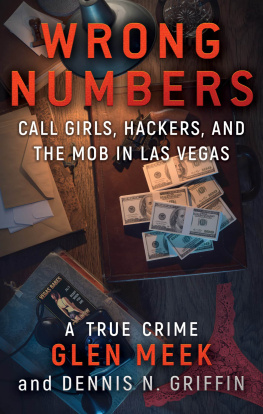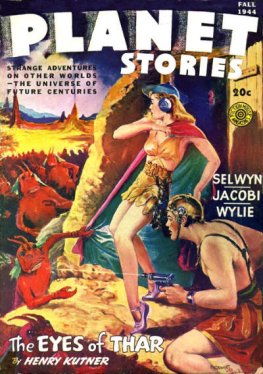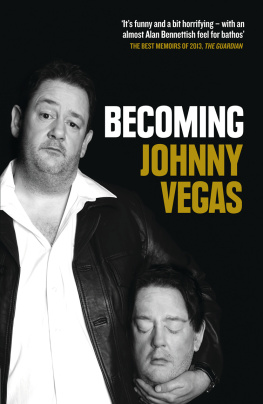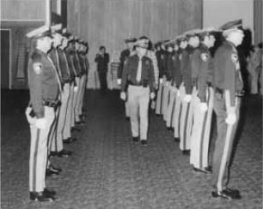WRONG NUMBERS
CALL GIRLS, HACKERS, AND THE MOB IN LAS VEGAS
A TRUE CRIME
GLEN MEEK
and DENNIS N. GRIFFIN
WildBluePress.com
WRONG NUMBERS published by:
WILDBLUE PRESS
P.O. Box 102440
Denver, Colorado 80250
Publisher Disclaimer: Any opinions, statements of fact or fiction, descriptions, dialogue, and citations found in this book were provided by the author, and are solely those of the author. The publisher makes no claim as to their veracity or accuracy, and assumes no liability for the content.
Copyright 2019 by Glen A. Meek and Dennis N. Griffin
All rights reserved. No part of this book may be reproduced in any form or by any means without the prior written consent of the Publisher, excepting brief quotes used in reviews.
WILDBLUE PRESS is registered at the U.S. Patent and Trademark Offices.
ISBN 978-1-948239-51-6 Trade Paperback
ISBN 978-1-948239-50-9 eBook
Interior Formatting/Book Cover Design by Elijah Toten
www.totencreative.com
Table of Contents
PREFACE
The city of Las Vegas has had a love/hate relationship with prostitution since the citys inception in 1905. During Las Vegas incorporation in that year, land adjacent to the railroad tracks was sold to private entities in city block-sized parcels. One of those blocks, in an area off of First Street from Ogden to Stewart, was Block 16, a section designated for saloons that eventually became the citys red-light district.
For years, prostitution, among other vices, flourished in Block 16, and was not merely tolerated, but was, for all practical purposes, officially sanctioned. In those days, a widely held libertarian view in Nevada was that vice in all forms, whether it be gambling, liquor, or prostitution, was best segregated in officially recognized areas where it could be controlled and taxed.
After the onset of World War II, however, attitudes in Las Vegas began to change, at least regarding prostitution. Federal intervention in the state contributed to this change of heart, particularly when the US Army established the Las Vegas Aerial Gunnery School to train gunners for military aircraft just north of the city. Many years later, that base would develop into Nellis Air Force Base, which exists to this day.
Military officials in the 1940s did not hide their aversion to brothels near one of their training camps. And by the time the Las Vegas City Commission shut down prostitution in Block 16 in 1942, community sentiment was already moving in that direction. Block 16 was shuttered even before Army officials formally asked for that to happen. However, shortly after the shutdown of Block 16, a brothel established on the outskirts of the city, in an area called the Meadows, was also put out of business, this time directly at the request of the military.
Although city and county officials had laws at their disposal laws which outlawed public nuisances, there were no state or county ordinances at that time directly banning prostitution. Like a game of whack-a-mole, bordellos would pop up, and when nearby residents objected, officials would bring the hammer down to close them.
In 1954, the federal government once again intervened. Roxies, perhaps the countys largest and longest operating bordello, was located just outside the city limits, in the cottonwoods off of Boulder Highway about four miles from downtown Las Vegas. In a raid at Roxies, the feds essentially put an end to the open operation of brothels in Clark County.
The raid targeted the brothel owners, a husband and wife team, for violations of the Mann Act, which outlawed the transportation of women across state lines for prostitution or other immoral purposes. The owners and a manager were all convicted of federal offenses and sentenced to serve between three and five years in prison.
Meanwhile, a crusading Las Vegas newspaper, the Las Vegas Sun , put together an undercover sting operation to ferret out corruption connected to Roxies, with a newspaper contractor posing as a hoodlum seeking to buy Roxies after the owners were convicted. Political and law enforcement officials were ensnared as they accepted offers of bribes to help re-open the brothel. The undercover operation also revealed connections between some of the corrupt politicians whod accepted bribes and Mafia figures who held hidden ownership in some casinos.
On January 3, 1955, Roxies was closed for the last time. It was the last brothel to operate openly in Clark County. In 1971, the Nevada legislature finally took action to regulate prostitution, allowing brothels in rural areas but banning them in counties with a population of more than 200,000 (today that threshold has risen to 700,000), which eliminated Clark County and Las Vegas.
Of course, this did not mark the end of the sex trade in Las Vegas or Clark County, it simply drove the vice deeper underground.
In the post-Roxies years, prostitutes continued to ply their trade, often in bars, on the streets, or as high-end call girls in the penthouses of some of the new high-rise resorts built in the 1950s and 1960s. But this type of sex-for-sale was much less centralized than the brothel business, and thus less susceptible to organized crime control.
In the 1980s and 1990s, escort services and outcall entertainment services began to expand explosively, as the Las Vegas Valley became one of the fastest growing population centers in the country. These services were legal on paper. They offered to send an escort to serve as a date or arm candy for a client, or as an entertainer whose nominal duty was to perform an exotic dance for a customer.
But police stings showed that in case after case, the vast majority of these escorts or entertainers were really call girls, peddling more than a simple dance or dinner conversation.
Although there were more than 150 of these outcall services licensed in Clark County, Nevada, in the late 1990s, most were owned by only a handful of operators. Once again, sex services were being consolidated into the hands of a few people, but this time the amount of money involved easily dwarfed the revenues of a local brothel. A client of Roxies might spend $5 for a forty-five-minute fling. A hotel guest in a major strip resort in the 1990s might spend well over $5,000 in a few hours with an escort. And where Roxies may have employed up to twenty hookers at any given time, there were hundreds, if not thousands, of escorts and outcall entertainers working in Las Vegas.
Once again, organized crime figures began to smell the money. And, according to the FBI, in 1998, a powerful New York crime family made its move to dominate the outcall entertainment and escort industry in Las Vegas.
But few peopleespecially wiseguyswere aware of how much the oldest profession was being influenced by the newest technology. Today, you can order practically anything over the internet, from Chinese carry-out to an X-rated dancer. But that wasnt the case in 1998.
In the 1990s, the heart of the call girl racket was the phone system. No phone callsno call girls. No call girlsno call girl racket. It seemed somebody in Las Vegas had found a way to surreptitiously control the calls by electronically diverting phone calls meant for one escort service and redirecting them to a rival service. At least thats the conclusion many escort service owners came to when their call volumes dropped dramatically for no apparent reason.













